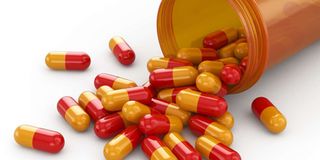What Kenya needs to win war against antibiotic resistance

In Kenya, antibiotic overuse is seen as one of the key drivers of antimicrobial resistance.
What you need to know:
- A common misconception is that AMR means that the body is resistant to antibiotics, antifungals or other medications given to treat the organisms causing the infection.
- To the contrary, it means that these organisms have developed the ability to survive the killing effect of the drugs designed against them.
Antimicrobial Resistance (AMR) occurs when bacteria, viruses, fungi and parasites no longer respond to antimicrobial agents-medication given to treat these infections. As a result of drug resistance, antibiotics and other antimicrobial agents become ineffective and infections become difficult or impossible to treat.
A common misconception is that AMR means that the body is resistant to antibiotics, antifungals or other medications given to treat the organisms causing the infection. To the contrary, it means that these organisms have developed the ability to survive the killing effect of the drugs designed against them.
The theme for this year’s World Antimicrobial Awareness Week was “Preventing antimicrobial resistance together,” a continuation from 2022, an apt theme that highlighted the collective responsibility needed in tackling this ongoing global pandemic and calls for cross-sectoral collaboration to preserve the effectiveness of antimicrobials.
Antimicrobial-resistant infections can be difficult and sometimes impossible to treat. A study published in the Lancet reported that 4.95 million deaths worldwide were associated with bacterial AMR, with 1.27 million deaths occurring as a direct result of bacterial AMR.
Sub-Saharan Africa was disproportionately affected, with Kenya showing 177th highest age-standardised mortality rate per 100,000 population associated with AMR across 204 countries surveilled. It’s important to note that this study did not include morbidity and mortality associated with fungal, parasitic and viral infections for which antimicrobial agents are limited.
Antimicrobial agents are a finite resource. If we were to do the viral social media 10-year photo challenge, antibiotics that showed activity against bacteria 10 years ago no longer show any killing effect.
This is quite alarming considering that the development of a new antibiotics requires close to 10-15 years and will cost about 1 billion USD. All of us are contributing to this resistance through misuse of antimicrobial agents. When bacteria and other microbes are exposed to antimicrobial agents, they adapt and become “smart.” They develop mechanisms to survive and resist the killing effect of these agents making the existing agents redundant.
Significantly, antimicrobial exposure occurs due to factors such as misuse of antibiotics where there is no evidence of an infection, use of antibiotics to treat a viral infection or suboptimal dosing to treat a confirmed infection.
The other factor is the use of antibiotics in agriculture and livestock that are treated with preventive antibiotics. Our industries are also responsible due to improper disposal of waste into the environment. Bacteria and other microbes are found in the environment and this exposure results in selective pressure allowing for development of mutations that confer resistance. This means that one can acquire a community infection by a multidrug resistant organism. Recently, there has been global recognition that preventive action is required using a One Health approach, which recognises the interconnection between people, animals, plants and their shared environment.
Four agencies have come together to achieve what no one sector can achieve alone: the Food and Agriculture Organization of the United Nations, United Nations Environment Programme, World Health Organization and World Organisation for Animal Health. In Kenya, there is an AMR national action plan modelled on the global action plan. This is led by the National Antimicrobial Stewardship Interagency Committee and its governance structures have taken one health approach in tackling AMR.
The fight against AMR calls for collaboration across all sectors to ensure that we win this war and must be addressed through a One Health approach. Everyone has a role to play to safeguard the reduction of antimicrobial agents.
Antibiotics are only needed to treat infections caused by bacteria, with some infections resolving on their own without the need for antibiotics. Viruses are not treated by antibiotics and colds and flus will not respond to antibiotics. When antibiotics are not needed, they won’t help and will still cause side effects in addition to contributing to the development of antimicrobial resistance.
Prevention is key, and we should take simple measures to keep ourselves and others healthy. This includes washing your hands with soap and water for at least 20 seconds or using hand sanitiser that contains at least 60 per cent alcohol because keeping your hands clean is one of the best ways to prevent infections and spreading germs, drinking clean and safe water, getting the recommended vaccines that help protect against preventable diseases including resistant infections and using antibiotics only as recommended by a health care practitioner.
We all have a role to play. Let’s all come together and do our part to safeguard our future.
Dr Gicheru is a senior instructor, Department of Pathology, Aga Khan University Medical College, East Africa and consultant clinical pathologist at Aga Khan University Hospital.


